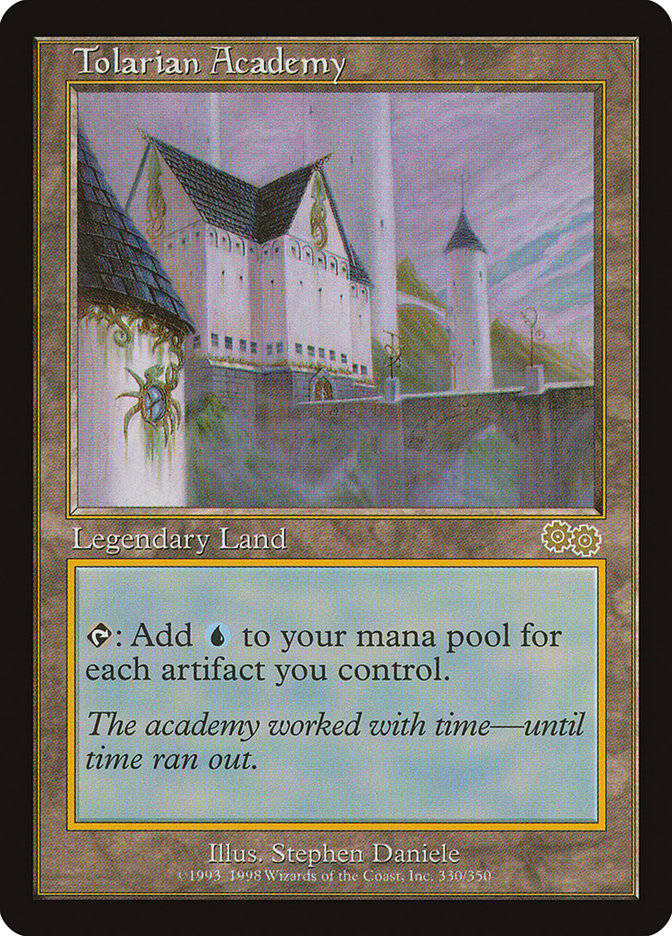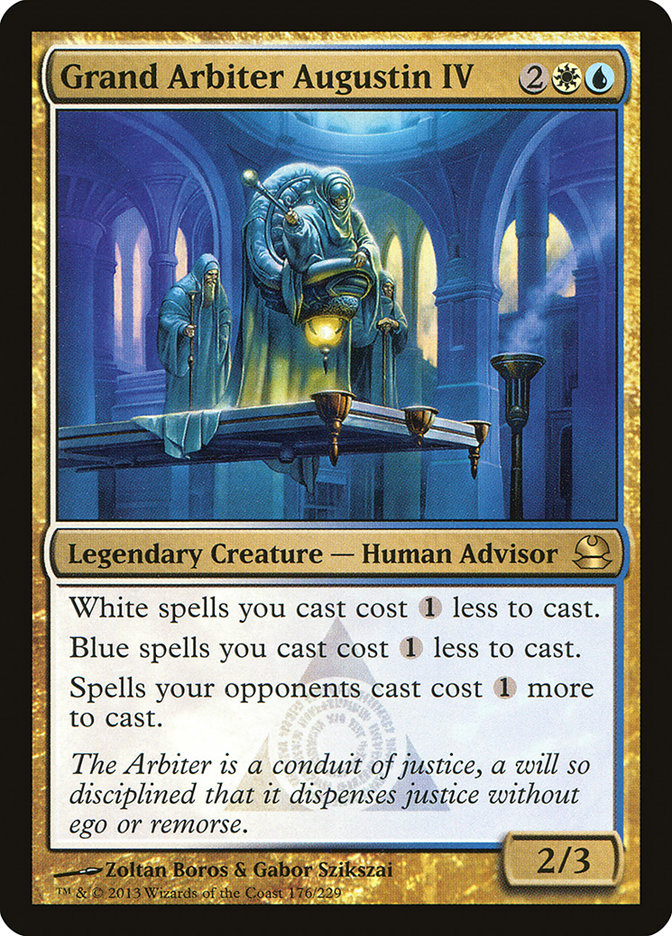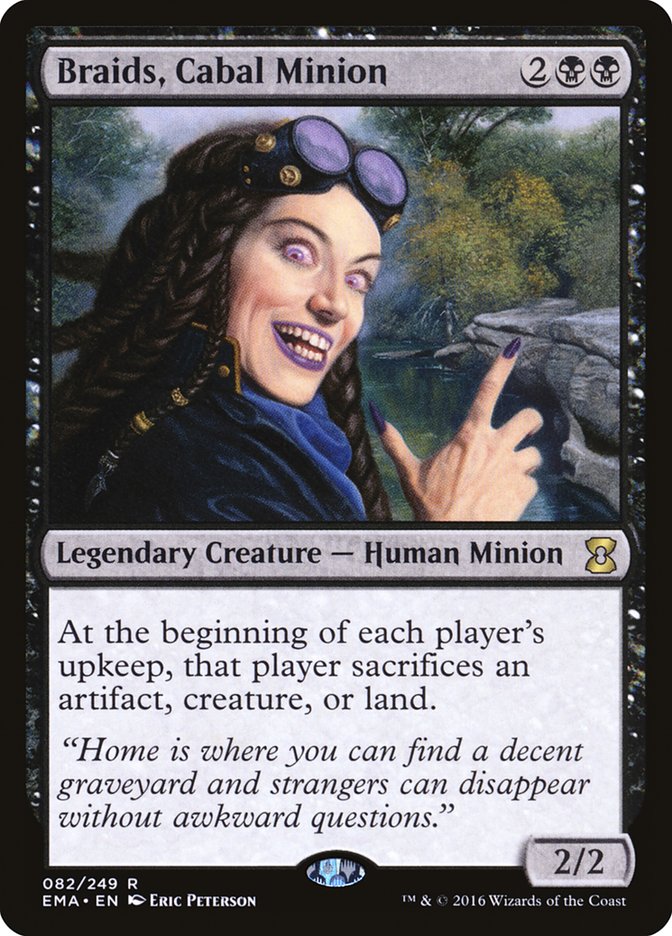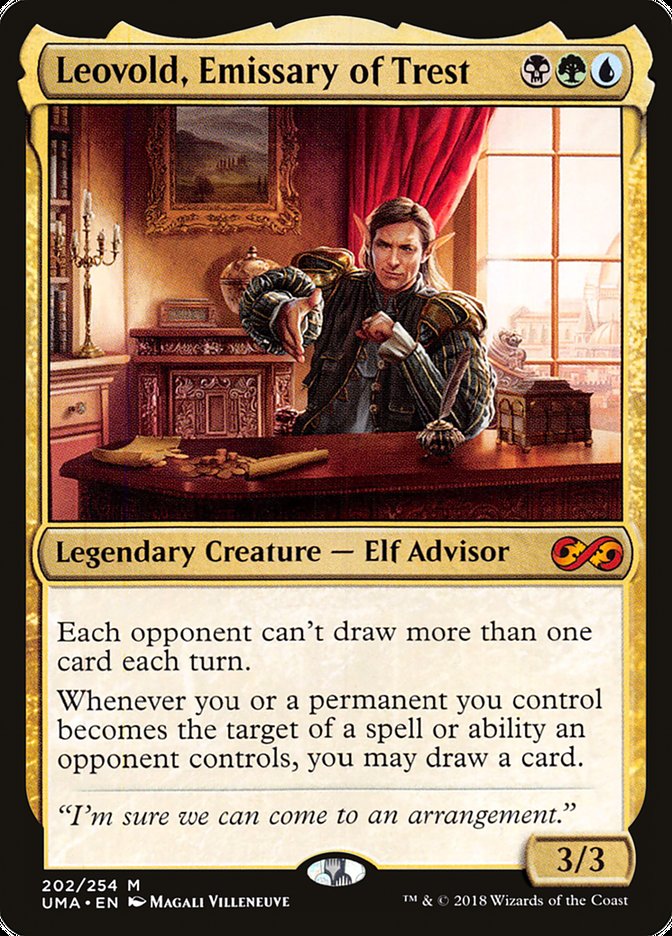As we announced in this past cycle, we’re taking a look at the Commander Philosophy document with an eye toward updating and modernizing it. We don’t have any intention of uprooting the format’s foundation—that it is, and always will be primarily a social format, a respite from tournament Magic. Still, there are lots of things worth thinking about. I firmly believe in taking your brain down paths that you don’t necessarily intend to walk, just to stretch you mental legs, as it were. Intellectual exercise keeps your mind sharp and it has the second level effect of making sure that your dogma stands on solid ground. And you never know what you’re going to discovery along the way.
I’ll offer a rather large caveat here: this is me thinking out loud. None of what follows has been a deep discussion that the Commander Rules Committee (RC) has engaged in. We’ve touched on some of them tangentially or occasionally floated things, but not with any depth. These aren’t plans; they’re the kinds of thought paths I take when thinking about thinking about the format (save for when I specifically mention this is what the RC is doing). Sometimes I bring thoughts to meetings. Sometimes I jettison stuff before we talk. Either way, being able to reasonably discard options—even if they weren’t likely in the first place—can only strengthen the position you hold.
One of the questions we’re exploring is “What is Commander?” We all might have some different ideas on how to articulate the answer. Unlike other formats, you can’t just limit an answer to the mechanical structure (deck construction, color identity, life totals, etc.). Commander is also an ideal. That’s why it has a philosophy in the first place. Commander is the anti-tournament format. It’s a place where fun is encouraged, and not just fun for yourself, but everyone involved. To some extent, it’s a place in which building a suboptimal deck is actually better than building the absolute best (which is something I understand that some folks simply can’t wrap their brains around; I fully grasp the seemingly counter-intuitive nature of the idea). The secret to this format is in not breaking it.
The anxiety comes from trying to take something so ethereal and make it concrete. We’ve done a good job over the years of expressing what the format wants to be, and that message has resonated with enough people to make the format extremely popular. But it’s also popular with some people who don’t care about the message, just the mechanics. That’s why Rule 0 is so important, and why we decided to formalize it. Pre-game communication is part of the format’s DNA. For the best times to be had by all, everyone has to be within some boundary of agreement stylistically. What I wonder sometimes is how we (meaning the RC) might enhance that communication or if leaving less in the gray area is better for everyone concerned.
Enhancing our communication is one of the reasons we formed the Commander Advisory Group (CAG). More voices repeating our message get it to more players and one of the reasons some of the CAG members were chosen is the number of people they reach. I’ve been surprised a few times that even in our information age that there were things about the format that some folks didn’t know, but I keep reminding myself that it’s still our responsibility to communicate, not the players’ responsibility to be communicated with. It makes sense to me that if I’m going to get invested in something to find out everything I can, but not every player is the fully invested one, and we have to find a way to speak to them as well. You don’t know what you don’t know, so more outreach means a greater percentage of the player base hears the sound bites like “build casually, play competitively” or “create the games people will remember, not the ones they’d like to forget” as well as knowing how and where to find the resources that they want and need.
Enhancing communication is more than just repeating old messages and sound bites, though. It’s crafting new ones, which is part of what modernizing the philosophy document will be about. We want to bring the spirit of Commander stylistically into today without losing its roots. Again, this sounds fine in the abstract. Getting there concretely is part of an ongoing effort that we’ll hopefully bears fruit by the next update, around the time of Core Set 2020‘s release.
One of the ways we’ll be able to hear more voices is by putting ourselves out into the field more often, outside of our local environments. For example, fellow RC member Scott Larabee and I will be attending SCG CON in a few weeks (you should too!). We’ll be doing more than just spellslinging. I’ll be doing a deckbuilding panel with Brian David-Marshall, Gavin Verhey, and Justin Parnell, and Scott and I will be doing an “Ask the RC panel.” You can already submit questions now by following the link to the panels page. Other fellow RC member Toby Elliott will be joining Scott and me at Gen Con in Indianapolis this summer. We’re still working on getting our fourth, Gavin Duggan, on board for the first in-person meeting we’ve had in quite a while. We’ll see which CAG members we can get there as well. Stay tuned for what we’ll have scheduled. If you’d like one or some of us to visit your event or environment, talk to me and we’ll see what we can make happen.
So what does leaving less in the gray area look like? That becomes a trickier question because while we support a particular style of play, we recognize all styles as valid (please note that validity does not necessarily equate to what we see as healthy). Our preference, and the one that resonates with the core demographic of Commander, is the game that plays out a little longer and gives everyone an opportunity to get into the game, and then makes awesome stuff happen.
We’re not opposed to somebody winning; it’s really okay for Commander games to end. We just don’t like them to end too soon. When someone asks me what’s too soon, my general answer is that anything that happens Turn 10 or later is fair game, even the most broken, silliest things. Would I slip this backward to Turn 9? Maybe. Would I keep sliding back to Turn 3? No. Again, this is a stylistic preference, and one we believe makes the format the most accessible. We’d like Rule 0 to solve any problems in this regard; if everyone is of the same mind about trying to combo out as fast as possible or to durdle as long as they can, then that’s great. The question on the table at the moment is how much additional action we should take for the cases in which Rule 0 is insufficient.
The first question to answer there is, in what percentage of games does Rule 0 not work? If it’s tiny, then we wouldn’t need to do much. If it’s significantly larger, we’d need to do more. If it’s an overwhelming majority, then that’d be a sign the rule isn’t working at all. I strongly believe we’re in the middle ground; it’s just where along the continuum we currently stand. As Rule 0 evangelism increases, the slider will move. But this is a thought exercise. It’s about what actions would we take if we thought we needed to take action, so please consider what follows in the context of me thinking about thinking, not thinking about doing.
For the cases in which Rule 0 doesn’t work (to include the folks who are willing to only see the strictures laid out by the Banned List), a Banned List is the only other option. One of the issues inherent with Rule 0 is that people will disagree on what certain descriptors mean. Even if we came up with a rating scale for decks (and I’ve seen a few pretty clever ones), players will (generally without malice aforethought) consider their decks one tier and their opponents consider it another. This kind of disagreement makes harder corners more desirable—at least along this axis, which is the line of thought we’re following.
The first question to answer is what we’d be trying to accomplish. Earlier, I laid out two basic criteria: try to make sure games don’t end too early, and give everyone an opportunity go get into the game. Along those lines, we’d have two basic categories: cards that make stuff happen quickly and cards that take the game away from the other players (which winning too quickly also does, but we’re talking about actively taking it away, assuming the game isn’t already over). The first one would be all about fast mana and cards that are cheap combo enablers. The second would be various taxing effects and some cards that say “can’t” in a blanket fashion. We’d still add a third category for cards which create undesirable game states, which is a bit of an extension of the second category.
There are cards that fit the first category already on the Banned List. We even have a category for them. Channel, Tolarian Academy, and Fastbond fall within its bounds. Continuing down that road (and perhaps to the horror of many players), I’d certainly add Mana Crypt, everyone’s favorite whipping boy Sol Ring, Mana Crypt, Grim Monolith, and anything else cheap that produces more mana than it costs to cast. Things already on the Banned List for other reasons, like the Moxen and Black Lotus, certainly fit here. The second part of the category would include the cheap combo enablers such as Flash, Hermit Druid, Ad Nauseam, and friends. This category wouldn’t be about neutering combo decks, but about making them slower and somewhat less reliable, which would probably mean Gifts Ungiven would stay—but there are compelling arguments to the opposite. Again, once we get to a solid number of turns, whatever happens is fine (so long as it doesn’t violate the other categories, which we’re about to take care of).
For me, the exemplar of the second category is Grand Arbiter Augustin IV. For very little mana, your things are cheaper and everyone else’s are more expensive. You get to play and they don’t. Various other STAX and resource-denial cards, like Winter Orb, go here, and it would just be a question of how far the limits might go. Certainly, another card that folks bring up, Iona, Shield of Emeria, would go here. There’d probably be a pretty lively debate over whether or not Trinisphere fits. The other spirited discussion would be over mass land destruction. I’m generally okay with MLD as an immediate win condition, less so if it unnecessarily drags out a game. The problem with that consideration is that there are times when a card is put into a deck for the first case and gets used in the second, so to what lengths are we willing to try to go to protect players?
The third category basically rolls together what we currently call Creates Undesirable Game States and Interacts Poorly with the Format. It includes cards that are dangerous coming out of the command zone, like Braids, Cabal Minion; Leovold, Emissary of Trest; and Rofellos, Llanowar Emissary. Derevi, Empyrial Tactician might get added here. I’d still add cards like Biorhythm and Worldfire here, but wouldn’t be 100% committed to them; they’re definitely not the hills I would fight on. Many of the other cards already on the Banned List, like Griselbrand, Tinker, and Sundering Titan, would still fall here (although Sundering Titan would obviously also go under the previous one). And maybe, just maybe (and I’m really stretching it here), with the fast mana gone, there’d be an argument that Primeval Titan and Sylvan Primordial could come back. The problem is obviously that green still has ramp spells, which let both of them run away with the game pretty early.
One of the thoughts to find some middle ground is a tiered Banned List. Start with a baseline, anything-goes list, and then step down (or up, however you choose to look at it) from there, each step banning additional cards plus the ones from the step before. You might even be able to make it a two-directional slider. Zero is nothing banned. To the left is the competitive path and to the right is the casual/social, so you effectively have a split format (which brings its own problems).
The tiered Banned List suffers from the fatal flaw of being a burden to maintain and a real monster to message. The weightiest ends of either the stepped list or the slider list could have triple digits in cards. Players would have to know multiple lists (which might be easy if it’s two, but much harder if it’s a dozen: “Wait, I thought that was Tier 7.” “No, it’s Tier 6.”). It’s not that I don’t think players aren’t capable of doing it; it’s that there would be a diminishing desire to. We are all capable of stuff that we don’t want to do, especially in our leisure hours. We’d prefer to not lay too many burdens on you in order to enjoy the format.
One more time, this whole exercise is just me thinking about thinking. Please don’t panic about anything I’ve said here. Solving problems involves understanding both what you’re trying to accomplish and how you’ll approach solving it, so looking down a line that you might not otherwise follow can still reap great benefits.
Sheldon Menery’s Deck Database
Check out our comprehensive Deck List Database! Click each section for lists of all my decks.
Signature Decks
These are the decks that define my personal play style to the greatest degree and to some extent lay the original foundation of the format. They’re also the ones you’re most likely to see me bringing along to spell-sling at an event.
The Chromatic Project
The Chromatic Project started as an effort to build at least one deck of all 27 possible color combinations, which was expanded to 32 when we finally got four color commanders. There’s more than one of some combinations, mostly because I have a Temur problem, plus some partner combinations are too enticing to pass up.
Mono-Color
Guilds
Shards and Wedges
Four Color
Five-Color
Partners
The Do-Over Project
The Do-Over Project is the next step after the Chromatic—building a deck with each of the same Commanders, but not repeating any cards save for basic lands (props to Abe Sargent’s “Next 99” idea). The Do-Over Project is still ongoing because we keep getting saucy new sets with creative and colorful commanders to build new decks with.






